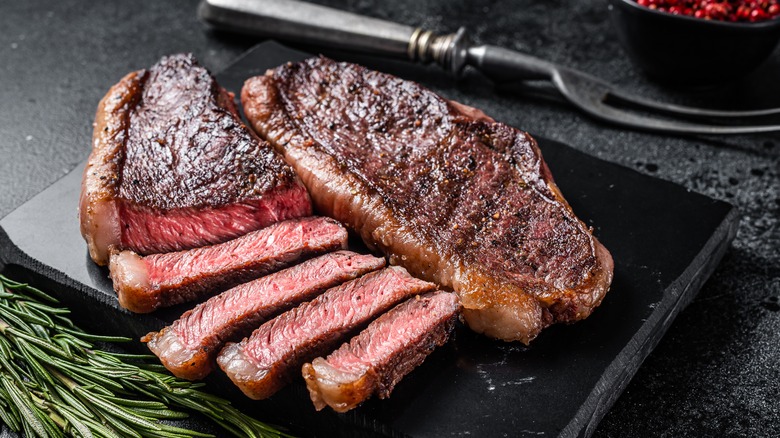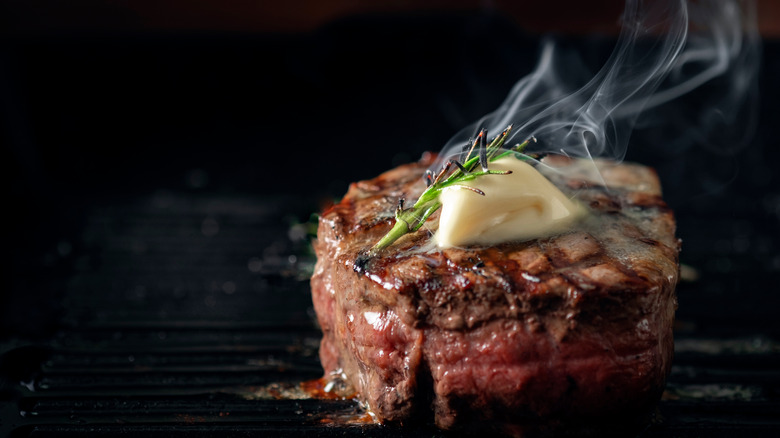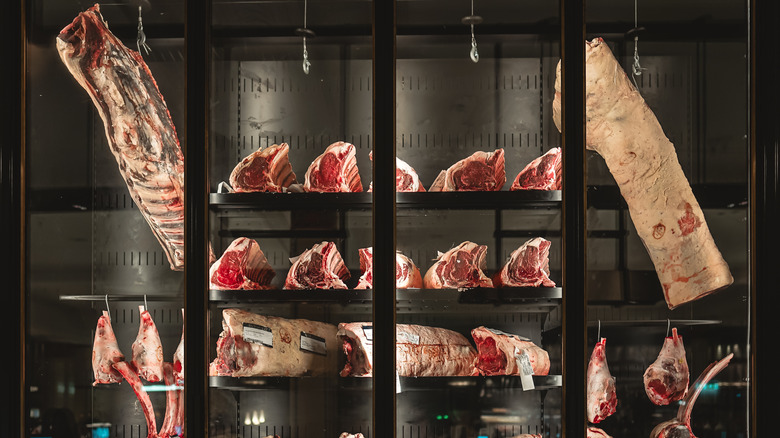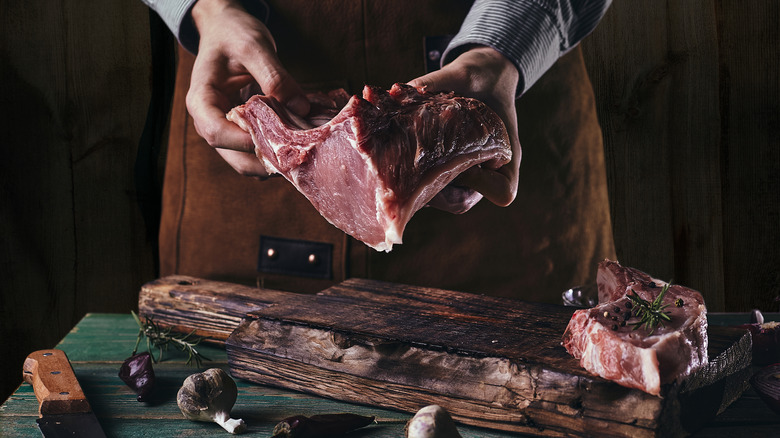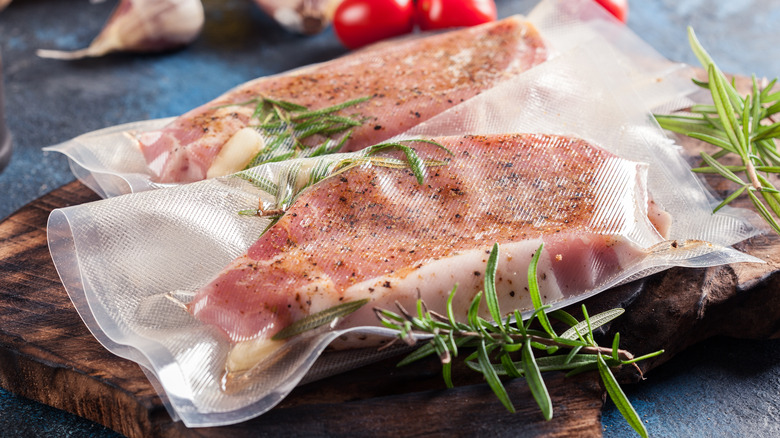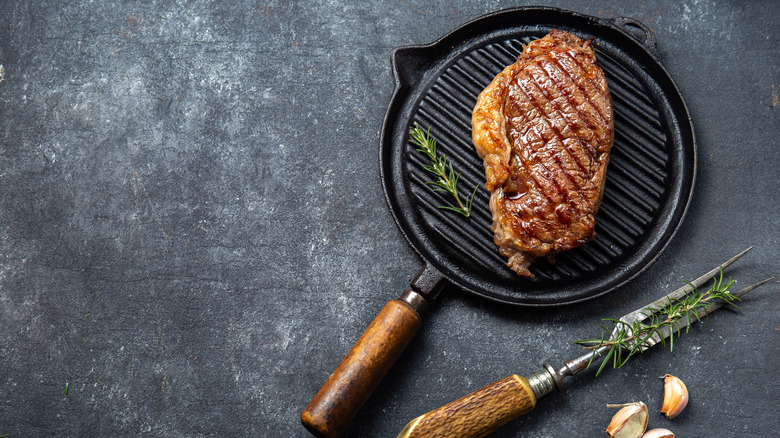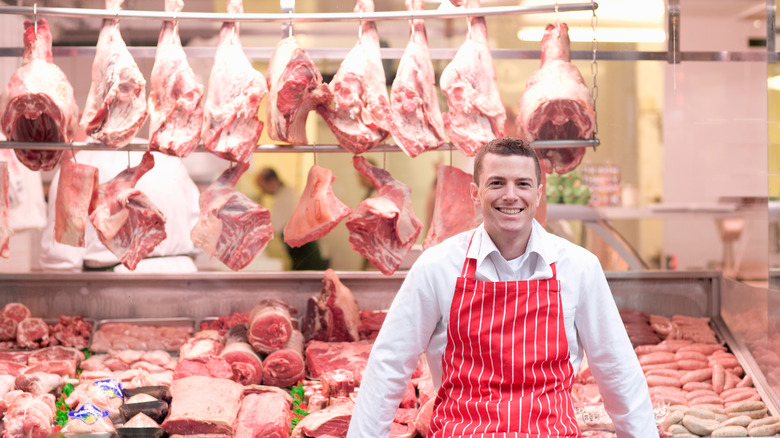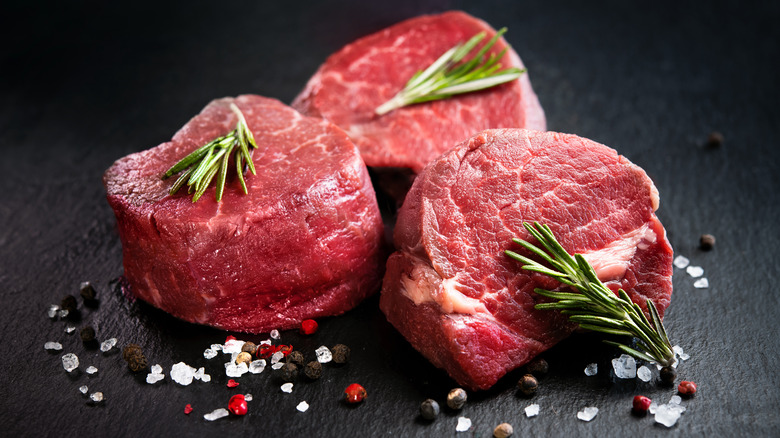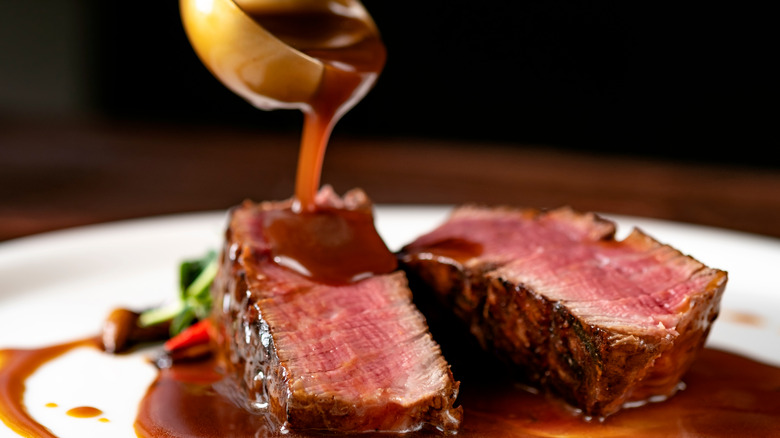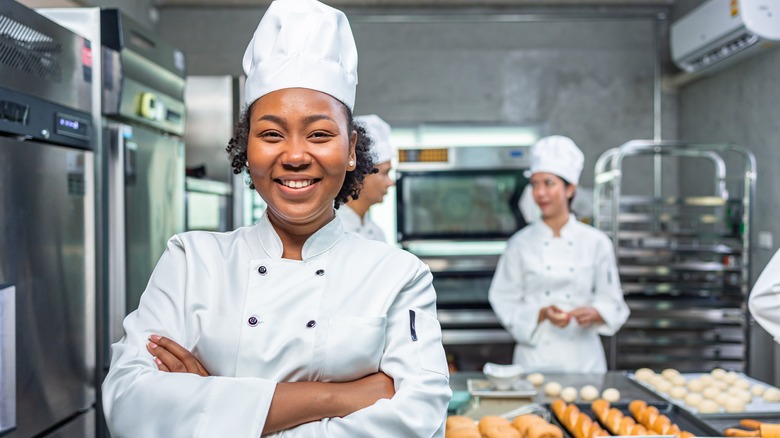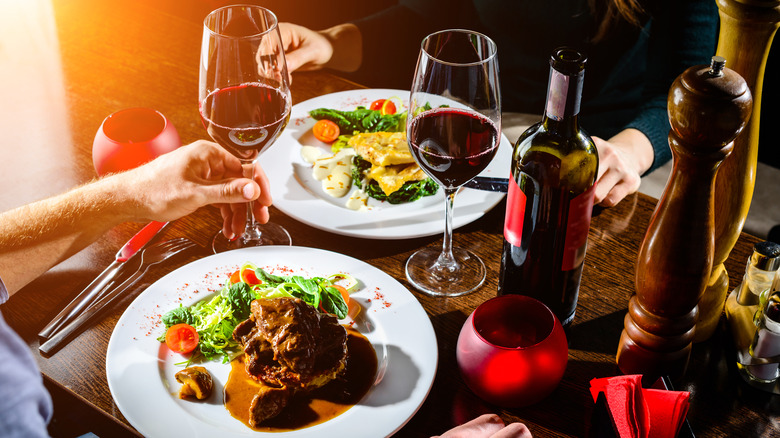Why Steaks Always Taste Better At A Restaurant
For those of us who enjoy a nicely-seared slab of red meat now and then, steak is often considered the highest form of carnivore candy. But have you ever noticed a discernible difference between the taste of a steak cooked at home and the highly flavorful steak you receive when you dine out at a restaurant? Before you get all self-conscious and defensive about your cooking skills, let's get one thing straight: We're not saying it's impossible to pull off cooking a great steak at home. With the right techniques, you can definitely plate up a steak in your own kitchen that you can be proud of. That said, the fact remains that restaurants tend to have a few tricks up their sleeves to produce intensely flavorful steaks that often surpass our own efforts.
Some of you might feel like no matter what recipe or method you try, you never seem to perfectly recreate the stratospheric levels of flavor, texture, and tastiness that you encounter when you eat out at a steakhouse. As it turns out, there are a few good reasons for that — some of which may surprise you. Here's why steaks always taste better at restaurants.
Compound butter is key
Butter. Such a simple and widely used ingredient, yet when it's softened and mixed with just a few other fixings, it transforms into a complex, unctuous bomb of fat-sealed flavor known as compound butter (via Webstaurant Store). A wide range of different ingredients that can include things like fresh herbs, roasted garlic, orange zest, brown sugar, lime juice, and chili peppers are whipped with butter to inject a massive amount of extra flavor into it. Restaurants often use compound butter to enhance the taste of everything from chicken and waffles to cuts of steak. In fact, according to Anthony Bourdain, the reason why everything at restaurants tastes better generally comes down to one thing: copious amounts of butter.
There's a good chance that when you order a nice steak from a great restaurant, compound butter was involved somewhere along the way. Some steakhouses like Fleming's even offer diners a choice of compound butters to select from for their steaks, like smoked chili butter or herbed horseradish butter. Aside from the flavor it imparts, a dollop of compound butter can also add some highly-appetizing visual appeal to the plate. Be honest: Is there anything more mouth-watering than the sight of compound butter seductively melting down the charred edges of a freshly grilled steak? The flavor-packed compound butter that the kitchen whipped up to baste your beef with is a big reason why that restaurant steak of yours tastes so unbelievably delicious.
Dry-aging adds major flavor
Dry-aging is another step that restaurants often take to deliver some big flavor in their steaks. But what does this process entail, exactly? According to Cook's Illustrated, dry-aging is when large cuts of steak are left in special refrigerated rooms that consistently circulate cold air around each piece of beef. Enzymes in the steak's muscle tissue slowly break down and soften the meat, deepening its natural flavors and vastly improving its taste and texture along the way. Essentially, the dry-aging process tenderizes steak and condenses the flavor of its beefiness through evaporation. In other words, you can think of dry-aging as a rather time-consuming way of concentrating the meat's flavor.
While many of us have heard that it's best to pat steaks dry before cooking them, it's safe to say that the dry-aging process for a high-quality steak in a restaurant is a longer procedure that's a bit more involved and difficult to do at home. So if you're wondering why that ribeye at your favorite steakhouse is packed with outrageous flavor, it's probably because it was professionally dry-aged in its own special climate-controlled fridge for a while. And since most of us don't have the space or equipment to safely dry large slabs of raw beef at home for long periods of time, restaurants have the upper hand here once again.
Direct access to suppliers gives restaurants an advantage
Knowing the right people and having the right connections comes with certain privileges in life — even when it comes to steak. According to Miami Beef, restaurant owners often depend on big distributors and meat processors for their cuts of steak. The direct relationships with meat suppliers give kitchens special access to top-notch beef products. Sounds like something you should get in on, right? Not so fast. Because many food suppliers are structured to only do business with licensed food vendors like restaurants, they typically don't work with the general public — though there are still some distributors who will sell directly to consumers (via Fit Small Business).
Some of these operations, like the one at Miami Beef, are truly impressive in their size and scale, producing up to 100,000 pounds of beef over the course of an eight-hour shift with the ability to customize orders. Having direct access to some of the highest-quality cuts of beef in bulk makes it much easier for restaurants to pump out consistently great steaks from their kitchens. So when you go out to eat at a steakhouse, you're not just visiting a restaurant — you're essentially being handed the keys to some special cuts of meat that might be difficult to track down at the places that you normally shop.
The sous vide method is a secret weapon
You may have heard the term sous vide before, but if you're unaware of what it means, allow us to enlighten you. Sous vide — a French term that translates to "under vacuum" — is a cooking method that involves submerging vacuum-sealed food in temperature-controlled pots of water (via Anova). There are several advantages to using this method, such as being able to cook food to a precise level of doneness while maintaining its moisture and succulence. You also don't have to babysit food while it's cooking sous vide — the machine does it for you. The sous vide cooking method can be used for a variety of dishes with all kinds of different ingredients, but where it shines the most might just be steak.
According to Food & Beverage Magazine, it's very common for steakhouses around the country to pre-cook steak using sous vide. The reason so many chefs use sous vide for steak is that the temperature settings allow for precise temperature control and dependable, consistent results. Sous vide makes it possible for restaurants to keep partially-cooked steaks warm by the stove, ready to be finished on the grill as orders come in — all while maintaining tenderness and the ideal temperature. So if you go out for a steak and take that first juicy bite and notice its perfect color, it might be due to the sous vide method being used in the kitchen.
Restaurants use high-quality pans
As you can imagine, pans play a big role in the cooking process. Different types of pans have their own unique strengths and weaknesses, depending on the material that they're made from: while cast iron pans can last a lifetime, they're also heavy to handle — and even though stainless steel pans are more lightweight, they also require more oil to prevent food from sticking (via Y.O. Ranch Steakhouse). According to Cook's Illustrated, the best choice for chefs is a high-quality carbon steel pan. It surpasses the alternatives for several reasons.
For starters, carbon steel pans are great at browning, which is caused by the Maillard reaction. The most delicious steaks at restaurants have a crunchy, brown crust on the outside that provides a nice contrast in texture with the soft tenderness on the interior. Restaurants know that carbon steel pans are a great vessel to achieve that crust — which makes them perfect for achieving that top-notch texture we're all craving when we go out for steak at a restaurant. They're also somewhat nonstick and they're lighter than cast iron pans. At the end of the day, a chef is only as good as the pan in hand, and you better believe that restaurants make sure the kitchen has some nice ones ready to go.
Butchers give a helping hand
Everyone knows that cooking great food is a lot easier when you have some helping hands pitching in. But imagine if you had a professional shopper who helped handpick your ingredients for you and even trimmed them up to your specifications. That's exactly the situation that some of the nicer steakhouses are in, as it's fairly common for restaurants to hire butchers to utilize their unique skill set for the sake of your steak. While many steakhouses do simply order pre-portioned meat, high-end places like Pappas Bros. and Smith & Wollensky have on-site butchers who cut every steak by hand to the restaurants' exact specifications.
In fact, some restaurants also function like butcher shops by offering meat markets. Alpine Steakhouse in Sarasota, Florida is a perfect example of this. It is a meat-centric restaurant that offers a full menu in addition to a deli, specialty grocery store, and a butcher shop with prime, hand-cut steaks.
They cook with intense heat
You might be thinking something like, "Hey, I have an oven at home. I can cook with intense heat too." While it's true that the oven in your kitchen can get hot, most models tend to max out at about 500 degrees Fahrenheit (via Cheffist). That temperature pales in comparison to what some broilers in professional kitchens can reach (via Blue Star). Believe it or not, some broiler models can reach nearly 2,000 Fahrenheit.
According to Best American Steakhouses, restaurants often use broilers for steaks since broilers offer a large surface that cooks consistently and evenly. Broiling at high heat is another great way to achieve that gorgeous browning on steaks from the Maillard reaction (via Beef It's What's For Dinner). Since these special broilers can tend to run between $15,000 – $25,000, it's safe to assume that most home cooks don't have these types of commercial broilers available to them in their own kitchens (via Webstaurant Store). By having access to high-quality, professional equipment like special broilers that can produce super intense heat, restaurants are able to cook steaks in a consistently hot atmosphere that most home kitchens can't compete with.
They bring steaks to room temperature and allow them to rest
There's a good chance that you've heard about a few important steps to take with steak. Among these, one of the most common recommendations is to bring the steak to room temperature before cooking and then allow it to properly rest afterwards (via Michelin Guide). Yet many home cooks may skip these steps, not fully realizing their importance for producing a restaurant-quality steak. Bringing steaks to room temperature allows them to cook more evenly and also loosens up their muscle fibers (via Steak School). According to Chef Kevin Thompson of the acclaimed New York Steakhouse in Bangkok, his kitchen always does this with steak, making sure to allow each cut to reach room temperature. He makes sure to give the steaks a proper resting period after they're cooked as well.
The resting period is particularly important; some even consider it one of the most crucial parts of the cooking process. The reason this is important is that the juices inside of the steak need a chance to reabsorb into the muscle fibers and settle back down throughout the meat. But how long should your steak rest for? Usually, the resting period should be anywhere between five and 20 minutes, with some wiggle room depending on factors like how long the steak was cooked for and how thick the cut is. Good restaurants understand the importance of this step and that's part of the reason their steaks are so tender.
Finishing sauces amp up the flavor
Once steak is cooked and hits the plate, it can be tempting to call it a day and dig in. While many home cooks consider it a job well done at this point, some chefs will take it a step further for the sake of flavor. Case in point: Chef Robert Irvine from "Restaurant Impossible" likes to grill up New York strip steaks and drizzle them in a homemade romesco sauce that's made with roasted red peppers, cherry tomatoes, garlic, almonds, and lemon juice. But that's just the beginning — delicious steak sauces don't stop there.
Some may insist that a good steak doesn't need any sauce, and while we're inclined to agree, we always appreciate an extra dose of flavor (like a rich demi-glace). The fact remains that some of the best steakhouses feature homemade sauces to compliment their cuts. B&B Butchers & Restaurant has a dish of sliced sirloin over hash browns with mushroom marsala sauce. Some steakhouses, including Knife, which is run by "Top Chef" contestant John Tesar, even offer different sauces on the side for their steaks, such as chimichurri and salsa verde. So if you find yourself enjoying a particularly tasty steak out at a restaurant and it's glazed with a little something special, take a moment and give credit to that delicious, lip-smacking finishing sauce.
Experienced chefs elevate the dish
This may seem obvious, but the reality is that amateur home cooks and trained professionals have very different skill sets. Experienced chefs tend to have a few tricks up their sleeves and they know how to properly and consistently prepare a steak to the perfect level of doneness. According to Chicago Steak Company, there are many steps that professional chefs take to pack their steaks full of flavor, and one of the most important of these steps actually involves doing absolutely nothing. And by "doing absolutely nothing," we mean having the patience and discipline to simply wait.
Allow us to clarify even further: Chefs know that when the steak hits the pan, it's best to let it develop a dark crust before flipping it, which adds tons of flavor and texture to the meat. Whether it's being able to quickly tell when a steak is properly cooked purely based on touch or having the bright idea to add a dollop of high-quality butter on top when it's finished, chefs have countless tricks up their sleeves to boost the deliciousness of your meal. So the next time you find yourself wondering how in the world your steak tastes so good, consider sending compliments to the chefs in the back of the house. All of those delicious flavors that you're enjoying are the result of countless hours of professional training, education, and experience in the kitchen. There's a universal truth to the adage that practice makes perfect.
Food psychology can influence taste
Clearly, a lot of factors contribute to producing a tasty piece of steak. Between the quality of the cut, top-notch equipment, and the chefs in the kitchen, there are a variety of influences that directly impact the food and shape the overall experience. But research in the field of food psychology suggests that there are a wide range of more subtle details that also play a vital role in how you perceive the quality and taste of your food (via NPR).
Dr. Charles Spence, an experimental psychologist at Oxford University, has made it his mission to learn more about how our brains process multi-sensory information — including seemingly trivial details like the color of our dinnerware and the lighting of a restaurant. At first blush, many of these influences may seem unimportant and practically inconsequential, but his research has uncovered some surprising discoveries. As it turns out, even the weight of your utensils can affect how sweet or salty your food tastes — and you're more likely to enjoy a dish if it has a more descriptive name on the menu. The next time you're out at a restaurant and you're blown away by a steak, there's a good chance that a number of subconscious influences are affecting your perception and taste in a way that you're completely unaware of.
